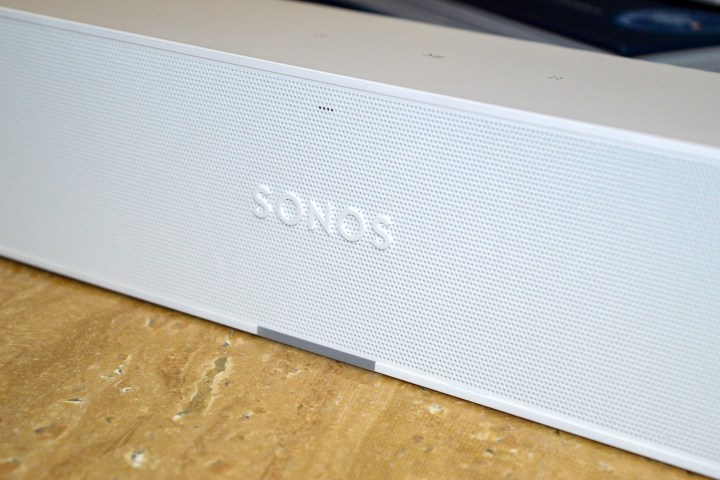The leaks, hints, and other implications were all true. Sonos today unleashed a new soundbar, its own voice control service, and new colors for an existing speaker.
Sonos Ray is the new entry in the product line and the new least-expensive option in the company’s home theater lineup. Sonos Voice Control — that’s the official name — perhaps is the most intriguing of the three releases, if for no other reason than it’s using a serious actor’s intonations. (Or an actor’s serious intonations. More on that in a minute.) And the portable Sonos Roam has some new colors on the way.
Digital Trends got a sneak peek at the new fare this week in New York City — let’s break it all down.
Sonos Ray
Sonos has had some great soundbars for a while now, from the now-discontinued Playbar to its two Dolby Atmos-enabled models — the $899 Sonos Arc, and the less-expensive-but-still-excellent $449 Sonos Beam Gen 2. The biggest issue really was (and still is) the price. While you get what you pay for, you’re going to be paying a lot. Sonos Beam made that pill slightly less painful to swallow, but you’re still talking about a nearly $500 soundbar.
Sonos Ray nearly cuts that price in half — it’ll retail for $279 when it goes on sale June 7 — and it takes up even less room.
“Homes have become movie theaters, fitness studios, gaming hubs and so much more, all supported by a streaming era that is no longer exclusive to just TV, music, and film,” Patrick Spence, CEO of Sonos, said in a press release announcing the new speaker. “Ray makes it easier than ever to enhance those listening experiences, thanks to its smaller size and impressive sound.”
Sonos is no stranger to packing a lot into a little bit of space. And it’s doing so here with three channels of audio. It uses special wave splitters to direct higher frequencies forward and outward, which gives the impression of having a center channel. All that despite only having four drivers — two midwoofers in the middle, flanked by a pair of tweeters.
We got a taste of the Ray’s sonic chops at our in-person briefing in New York City, and the new soundbar absolutely lives up to Sonos’ reputation for extracting maximum audio impact from surprisingly small speakers. The Ray, like almost all of the company’s products, sounds like it punches well above its weight. We’ll reserve final judgment until we get our review model in for testing, but we’re optimistic that the Ray will fare very well once we put it through its paces.
Despite its diminutive size, at least compared to Sonos’ other soundbars, you won’t be making a $560 stereo pair out of these things. Nor can you use them as surrounds. And, in fact, it’s only got an optical input, and no microphones, which means no Dolby Atmos, and no voice control. Again, you get what you pay for. But you can enhance that three-channel sound to a full 5.1 system with any other set of Sonos speakers that can be paired in stereo, as well as with a Sonos sub. That’s great if you already have a slew of Sonos speakers laying around, but a little harder to justify the trade-offs if you’re buying everything brand-new.
Sonos Ray still pairs with the latest Sonos app, of course, and it can use other wireless features like Apple’s AirPlay 2.
Sonos Voice Control
Perhaps the biggest announcement today is Sonos Voice Control. It’s being billed as a privacy-first feature, and its birth comes amid several tiffs with none other than Google, which didn’t want Sonos to be able to offer multiple voice systems in parallel (allowing you to easily switch between them). Separately, Google was found to be in violation of some of Sonos’ patents in regards to how the speakers work wirelessly.
All of that makes for some interesting timing, though it’s still inside baseball. The important part here is that Sonos Voice Control is coming on June 1 in the U.S., with France to follow later this year. (Sonos says other markets will come after that.)
And at risk of completely burying the lede, Sonos has enlisted veteran actor Giancarlo Esposito as the voice of Sonos Voice Control. As in Breaking Bad and Better Call Saul. And The Mandalorian. And The Boys. Or if you really want to go back, Homicide: Life on the Street, and NYPD Blue. Or The Usual Suspects.

And if you’re wondering how Sonos got Esposito to sit in a studio booth for what must have been days, barking out all the different responses you could imagine a voice AI would need — well, that’s not quite what he did. Surely there was a bunch of that. But this is the era of machine learning. And the machines have learned to replicate Esposito’s unmistakable speech.
“With careful recording, advanced processing and mastering, the voice is natural, unobtrusive, yet confident and engaging,” Sonos said in the press release.
Sonos says while Esposito is the first voice of Sonos Voice Control, his won’t be the last. (Our top picks for the French launch: Omar Sy, Jean Reno, Vincent Cassel, and Eva Green.)
Voice controls and always-on microphones, of course, spark discussions about privacy. Sonos says that requests are handled on the devices themselves, and not processed in the cloud. “No audio or transcript is sent to the cloud, stored, listened to, or read by anyone,” the company says. No word, though, on how that could limit improvements, but the launch feature set is impressive. You’ll be able to do almost anything with Sonos Voice Control that you can do with the Sonos app, including starting playback of tracks, artists, and playlists from several streaming services, adding or removing rooms from synchronized play, adjusting volume, and you’ll even be able to get a report on the remaining battery life on products like the Roam and Move.
Speaking of those two Bluetooth-enabled speakers, because Sonos Voice Control is on-device, it will also work when connected to a phone over Bluetooth — even if that phone isn’t running the Sonos app. Controls will be more limited — only play/pause, track skip forward/back, and volume will be supported, but that’s still a nice little convenience.
“Sonos is committed to delivering new experiences that effortlessly connect listeners to the content they love,” Joseph Dureau, vice president of voice experience at Sonos, said in the press release. “One of the most natural ways to connect to your music is with your voice, but when we speak to our customers, we hear that many of them have concerns about privacy and are dissatisfied with the accuracy, speed, and ease of use of existing voice services. Sonos Voice Control delivers the experience our customers want without compromise — one that puts speed, accuracy, and privacy on an equal footing.”
Sonos Voice Control will be available on new voice-capable products, and available as a free update on existing products. At launch, it’ll work with Sonos Radio, Apple Music, Amazon Music, Deezer, and Pandora. Noticeably missing from that list are Spotify, Tidal, and YouTube Music, though Sonos says they’ll be adding more services over time. We’re a bit disappointed that Sonos decided against supporting local music library access via Voice Control — something that Alexa and Google Assistant can’t do either.
Sonos Roam colors
Finally — as had already been teased and leaked — Sonos Roam is getting three new colors to go along with the existing black and white options.

New are “Olive,” “Wave,” and “Sunset.” In English, that’s dark green, reddish-orange, and a soft, light blue.
All three new colors are available starting today for $179.









